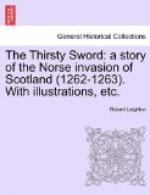Kenric and Allan, with Duncan Graham at their side, marched afoot, for both were wont to feel ill at ease in the saddle. Nevertheless Allan cast many an envious glance at the gallant knight who led them. Sir Piers was clothed in the most beautiful suit of armour that had ever been seen in that time. His horse was a powerful Spanish jennet that had belonged to Earl Hamish of Bute, and it was protected by a heavy breastplate and flank armour. The rider was splendidly armed from head to foot, his helm and coat of mail being inlaid with gold. At his left side there hung a long claymore, longer by three inches than Kenric’s great sword. In his right hand he held a ponderous battle-axe of solid brass, and from his pommel there hung a spiked mace whose head was as large as the head of a man. His belt was studded with precious stones. Not in all his army had King Alexander a stronger or nobler warrior than Sir Piers de Currie; nor had he one, either strong or weak, who had a deeper hatred against the Norse invaders, for they had burnt down his castle of Ranza, and by them had his own uncle’s castle of Brodick been razed to the ground and his uncle slain. He was to fight that day for his beautiful wife and his children, for the possession of his estates, for his revenge against his enemies, and for his King and country; and none who saw him could have doubted that he would prove a most valiant and powerful antagonist.
Kenric had on his crested helm of brass, and wore a shirt of steel mail. His knees and arms were bare, showing his firm muscles and the suntanned skin; on his feet he wore buskins of double hide, and his legs were protected by brass greaves. Over his back his longbow was slung beside his full arrow sheaf. At his right side was his dirk, at his left the sword of Somerled. On his arm he carried a small round shield studded with nails, though this was more an encumbrance than a defence, since his sword required the use of his two hands, and the shield might only be employed as a protection against arrows fired from a distance.
Sir Allan Redmain was attired in like manner. As to their islanders, some few of them of the better condition — as Duncan Graham and Ronald Gray — wore shirts of mail, but the larger number, so far from desiring armour when they came to close quarters with the enemy, even threw their plaids aside and fought in their shirts, bare legged, bare armed, bare headed. Many of them carried bows and arrows; all had either claymores or pole-axes, with daggers and targets.
They had marched some ten miles southward through the sheltered glens of Noddsdale when, mounting to the ridge of the range of hills that rise above the shores of Cunningham, they were met by a keen icy wind from the southwest. Below them stretched the wide Firth of Clyde, turbulent, angry with foam-capped waves. Far across the water rose the giant mountains of Arran, with their tattered peaks frowning in dark-blue blackness against the leaden sky, and through a rent in the clouds a long beam of sunshine shot, slanting down for a moment upon the soft green hills of Bute. On the nearer side were the two islands of Cumbrae, with a strip of gray sea between them, where lay the storm-tossed galleys of King Hakon the Old.




